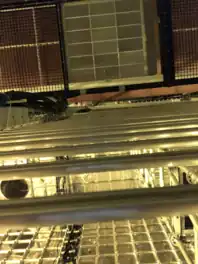
The ProtoDUNE experiment is a prototype for DUNE in development by CERN, which will measure neutrino collisions.[1] DUNE will use a liquid-argon time projection chamber to detect neutrinos, also known as a LArTPC.[2] Neutrino collisions knock electrons off of atoms and release light energy, both of which can be measured by ProtoDUNE. Scientists use a negatively-charged anode plane array (APA) to attract and record the path of the electrons, thereby recording information about the collision itself. The ProtoDUNE detector is around the size of a three-story house, and the DUNE project will use modules twenty times the size of ProtoDUNE.[3] ProtoDUNE was successfully tested in 2018; as of 2023 it is the largest LArTPC ever constructed.[2] Two detectors have been built at the neutrino platform, each containing around 800 metric tons of liquid argon. A cryostat is used to insulate the detector, which needs to be kept at temperatures of -300°F for the argon to remain liquid.[3]
Construction
It took two years to build the first ProtoDUNE detector, and another eight weeks to fill it with 800 tons of liquid argon.[3] Originally, one detector was built to be single-phase (ProtoDUNE-SP), using only liquid argon, while the other was built to be dual-phase (ProtoDUNE-DP), using both liquid and gaseous argon. The goal of the prototypes is to solve any engineering problems that DUNE might face before construction begins. A group led by Bob Paulos in the University of Wisconsin–Madison Physical Sciences Lab designed the APA for the single-phase detector, and the APAs were built by the UW–Madison group and the Science and Technology Facilities Council’s Daresbury Laboratory. In addition, CERN designed a cathode plane that would repel electrons. The dual-phase detector operated similarly, but with a slightly different array configuration. Although DUNE's neutrinos will be provided by the Long-Baseline Neutrino Facility, CERN expanded their existing network to use a particle beam to test the detectors.[1] The beam window system that allowed researchers to test ProtoDUNE was designed, fabricated, and installed by the Department of Energy's Lawrence Berkeley National Laboratory.[3]
Testing
In 2018, ProtoDUNE recorded its first particle tracks.[3] In 2020, researchers published a paper regarding the testing of the ProtoDUNE-SP detector. They used an 800-GeV beam of protons and electrons from CERN's SPS accelerator to test the capabilities of the ProtoDUNE-SP detector. In the test, the results from ProtoDUNE-SP were cross-checked with those from particle detectors located just before the detector. ProtoDUNE uses reconstruction software to differentiate an actual interaction from noise. This test revealed that the detector had a signal-to-noise ratio of fifty to one and that over 99% of the detector channels were working properly.[4] As of 2023, CERN is building ProtoDUNE II, which will include a vertical drift detector (ProtoDUNE-VD). ProtoDUNE II will contain four APAs and light sensors.[2]
References
- 1 2 Hesla, Leah (Jan 18, 2018). "The biggest little detectors". Symmetry. Retrieved Jul 16, 2023.
- 1 2 3 Kwon, Diana (Mar 31, 2023). "DUNE collaboration ready to ramp up mass production for first detector module". Phys.org. Retrieved Jul 16, 2023.
- 1 2 3 4 5 Roberts Jr., Glenn (Sep 18, 2018). "First Particle Tracks Seen in Prototype for a Neutrino Experiment". Berkeley Lab News Center. Retrieved Jul 16, 2023.
- ↑ "DUNE Collaboration Publishes First Scientific Article Using ProtoDUNE Detector". AZO Quantum. Dec 7, 2020. Retrieved Jul 16, 2023.